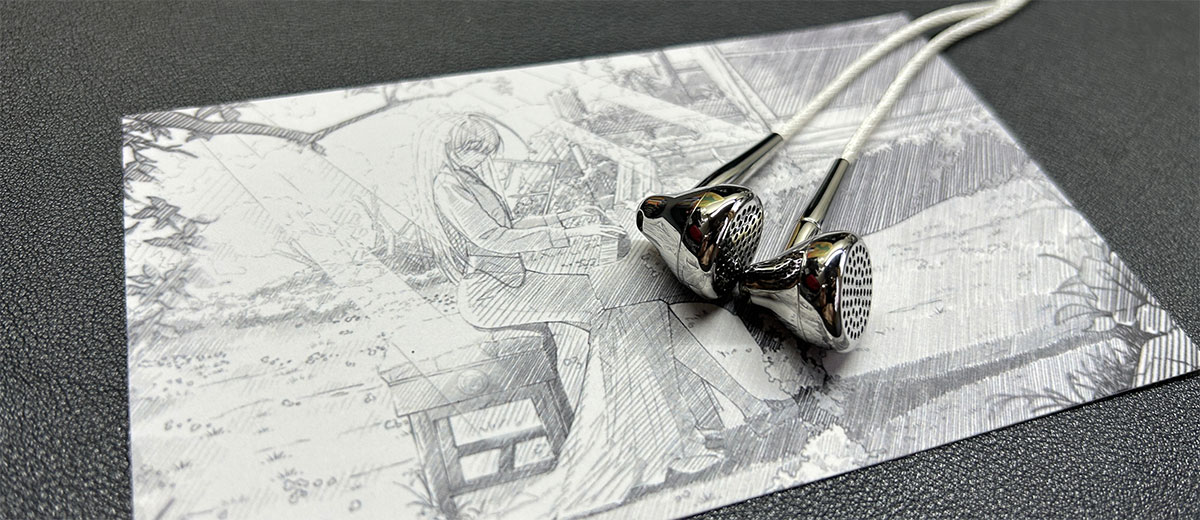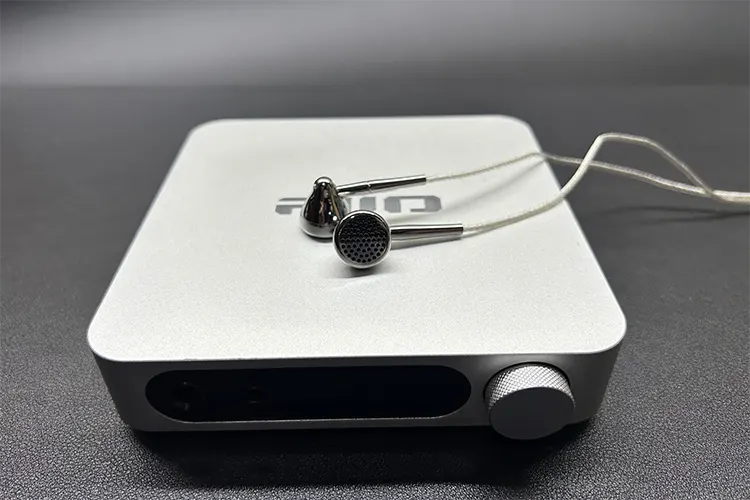Synergy
Efficiency
Despite having a sensitivity of 117 dB/Vrms and an impedance of 26Ω ±15%, the MOONDROP Pavane is deceptively power-dependent. On paper, it appears relatively easy to drive, but real-world testing shows otherwise
When plugged directly into a laptop, the Pavane sounds flat, lifeless, and severely lacking in dynamics. However, it scales dramatically with proper amplification.
Using a mid-tier dongle like the iFi audio GO Link Max via its 4.4mm output yields significantly better performance, revealing a more respectable level of detail and resolution.
Still, the Pavane only truly shines when driven by powerful desktop sources such as the FiiO K11, K11 R2R, and Shanling EH2 DAC/AMPs.
With a proper source, the soundstage expands, instrument separation sharpens, and dynamics come to life, providing a headphone-like presentation.
Pairings
The Pavane pairs best with warm, powerful sources that complement its lean bass and neutral-bright tonality.
Devices like the FiiO K11 R2R or Shanling EH2 with R2R architecture on NOS mode add body and smoothness to the midrange while enriching the bass response, making them ideal companions.
The ddHiFi TC35Pro E2 and iFi audio GO Link Max were able to drive the Pavane to listenable levels, but it didn’t have the same sound staging, harmonics, and instrument separation that I heard when the Pavane was paired with a more powerful desktop amplifier
The 7Hz Artemis39 fared better than the two dongles, with its warmer presentation and higher power output complementing the Pavane. However, I found it was still not sufficiently powerful to maximize the staging and resolving capabilities of the Pavane.
Selected Comparison
FiiO FF3
Technical
The FiiO FF3 utilizes a 14.2mm dynamic driver featuring a beryllium-plated diaphragm combined with a PU gasket.
It has an impedance of 45Ω and a sensitivity of 105dB/mW, making it moderately easy to drive with most portable devices, though it benefits from amplification for optimal performance.
In contrast, the MOONDROP Pavane is equipped with a 13.5mm external-magnetic long-stroke dynamic driver, incorporating a third-generation Diamond-Like Carbon (DLC) composite diaphragm.
It has a lower impedance of 26Ω ±15% (@1kHz) and a higher sensitivity of 117dB/Vrms (@1kHz), indicating that it should be easier to drive.
Despite its higher sensitivity and lower impedance, my testing shows that the Pavane benefits significantly from higher-output sources or dedicated amplification to fully realize its detailed and expansive soundstage.
This could be attributed to its tuning and driver design, which may demand more power for optimal performance.
Design
The FiiO FF3 features a polished 316L stainless steel body with a unique “drum” dual-cavity design inspired by musical instruments, accented by tempered glass backs with shifting geometric patterns.
It includes a high-quality silver-plated cable and modular plugs, but its 31g weight can feel heavy over time.
In contrast, the MOONDROP Pavane sports a polished stainless steel shell with a mirror-like finish that resists fingerprints better than similar designs.
Its smooth, seamless machining and lightweight feel make it comfortable for long use, though the lack of left/right markings can make fitting tricky.
In practice, I found the FF3’s smaller shell to fit more comfortably and securely in my ear. However, I never experienced any issues with the security or comfort of the Pavane, the FF3 was just better.
Performance
The FiiO FF3 leans toward a fuller and more dynamic presentation, thanks to its more pronounced low-end. Percussive elements such as kick drums, bass drums, snares, and floor toms have excellent body and impact, giving the FF3 a weighty and satisfying rhythmic foundation.
This bass-forward tuning also gives the FF3 a more balanced and cohesive sound in genres where low-end presence is critical, such as pop, funk, and hip-hop.
Vocals and upper-mid details, however, are less emphasized on the FF3. While male vocals and mid-heavy instruments like saxophones or rhythm guitars are played back with warmth and good body, they lack the clarity and nuance found on the Pavane.
The Pavane shines in upper midrange and treble finesse. Both male and female vocals come through with exceptional clarity, air, and delicateness.
String instruments such as violins and harps have more shimmer and detail, while cymbal and crash hits decay more naturally, with extended harmonics that feel more lifelike.
The Pavane also boasts a wider soundstage, which competes with full-sized open-back headphones when the Pavane is paired with a desktop headphone amplifier.
Instrument separation and imaging benefit greatly from this stage width, making the Pavane ideal for critical listening of acoustic, orchestral, or vocal-centric genres.
Mids are where the FF3 pulls ahead in weight and presence. Instruments like pianos, cellos, and guitars sound more robust and dynamic compared to the thinner, more neutral presentation on the Pavane.
One key distinction lies in scalability. While the FF3 maximizes its performance even from mid-tier dongles, the Pavane scales significantly with amplification. This makes the Pavane a more rewarding choice for desktop setups.
My Verdict
The MOONDROP Pavane flagship flathead earbuds are equipped with a high-quality attached cable, premium stainless steel build, and a bright-neutral leaning sound signature.
However, those who enjoy the fuller low-end and the more balanced sound signature of other earbuds may find the Pavane’s lean bass and analytical character less appealing.
Additionally, the Pavane requires a powerful desktop-class headphone amplifier to maximize its staging and resolving capabilities, limiting its portable usability.
Despite this, listeners looking for a premium-feeling, comfortable set of flat-head earbuds with a bright-leaning sound signature should give the MOONDROP Pavane a listen
MOONDROP Pavane Technical Specifications
- Driver: 1x 13.5mm DD
- Impedance: 26Ω±15%
- Frequency response range: 20Hz-20kHz
- Sensitivity: 117 dB/Vrms
- Termination plugs: 3.5mm/4.4mm








